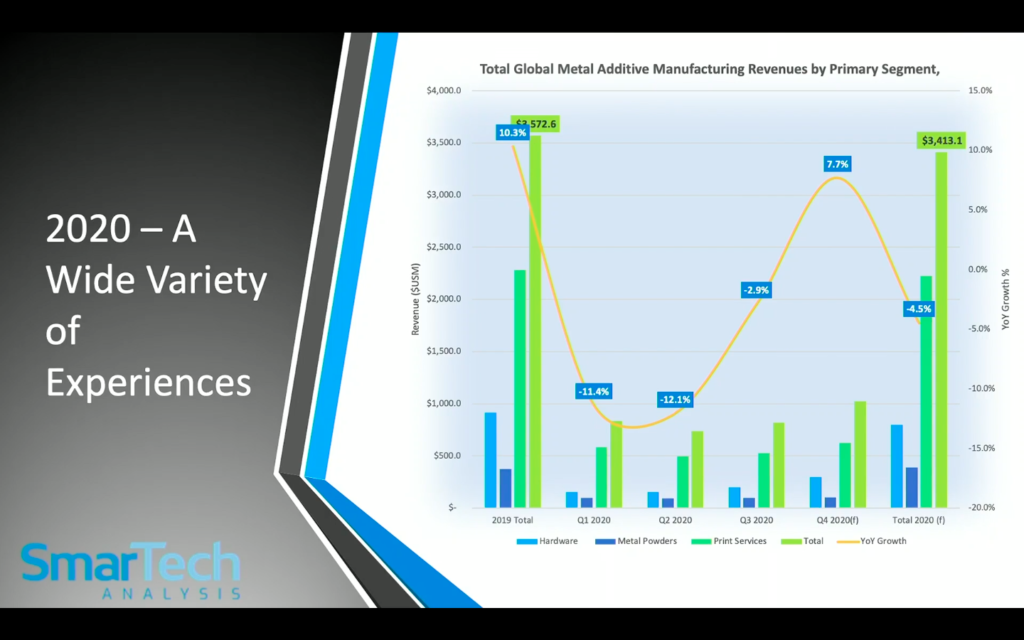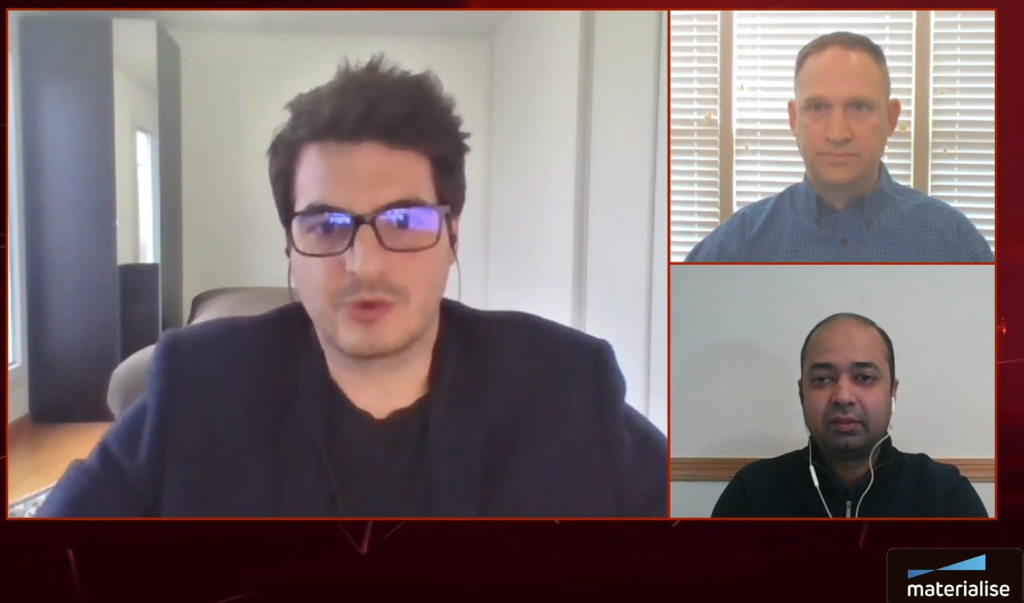As we know, the metal additive manufacturing (AM) market was not immune to the effects of collapsing global supply chains due to the COVID-19 pandemic in the early months of 2020. At the Additive Manufacturing Strategies 2021 conference, attendees from all over the world tuned in to watch virtual keynotes and visit virtual booths. The conference would have been an in-person event, but due to COVID-19, co-hosts 3DPrint.com and SmarTech Analysis pivoted to a virtual platform.
The conference kicked off with a keynote presentation from Materialise’s Market Manager, Lucas Hellemans. He described how Materialise is focusing on new materials and powerful 3D software. Software will play a crucial role in the future of additive manufacturing, and Hellemans described the first bottleneck people encounter when trying to use AM on scale compared to traditional manufacturing methods: process development. To validate and scale a 3D model into production, you need to optimize process development to create an ideal factory setup. Metal 3D printing contains a lot of parameters to optimize for mass producing a component.
Materialise has gone through the painstaking task of optimizing process development for using metal additive manufacturing systems to mass manufacture a component. You need machine specialists, material scientists, and other highly skilled workers to create a fully optimized process, largely through experiments involving a great deal of trial-and-error. When parts have specific qualities, the complex and time-consuming process of optimizing the production process is caused by the huge number of interdependent parameters that need to be optimized.
In addition to the complicated nature of making it easier to use metal AM for mass production, the technology had other struggles int he form of the COVID-19 pandemic, which, according to Executive Vice President of Research at SmarTech Scott Dunham, had a contracting effect on the metal AM market in the first three quarters of 2020. But he also mentioned that SmarTech’s analysis indicates that the metal AM market is poised to rebound during the fourth quarter of 2020. Dunham showed SmarTech’s annual market metrics and broke them down into three key opportunity segments where SmarTech tracks activity with their advisory services. Ultimately, the pandemic may reshape the metal additive manufacturing industry in a way that will yield overall growth, but the niche market was hit pretty hard.
In the following panel about small format metal 3D printers, John Barnes, Founder and Managing Director of The Barnes Global Advisors, spoke with Jonah Myerberg, Co-founder and CTO of Desktop Metal and John Hartner, CEO of ExOne. Myerberg initially spoke about the evolution of metal AM due to limitations of laser sintering. He said that, since scaling laser sintering operations are challenging and extremely expensive, more organizations and companies have sharpened their focus on metal binder jetting systems. Hartner agreed, and added that the pandemic has forced metal AM engineers to re-think relying on the existing global supply chain by decentralizing their supply chains and scaling up metal 3D printing operations locally.
The key point that the entire panel agreed on was that binder jetting technology is more scalable at less cost than laser sintering metal AM. Another key takeaway was that businesses should be paying attention to materials for small format metal 3D printers. There are hundreds of new materials available for metal additive manufacturers, especially for metal laser sintering applications. The three panelists agreed that binder jetting technology is set to grow in comparison to laser sintering and electron beam metal additive manufacturing.
The next panel, “Large Format Metal Printers” was led by Todd Grimm, President of T. A. Grimm & Associates, Inc. The panelists were Nitin Chaphalkar, Senior Product Manager for DMG MORI; Ankit Saharan, Manager of Research and Applications Development at EOS North America; and Zach Murphree, Vice President of Sales at VELO3D. The conversation centered around innovations in large-format metal printers. Large format metal printing has been booming, according to Saharan from EOS, and the company is continuing to explore how to scale up large format metal 3D printing.
Grimm asked how big a system has to be to qualify as a large format metal 3D printer. “Large is definitely growing”, according to Murphee from VELO3D. Saharan, from EOS, mentioned the main challenges to large-format metal 3D printing, saying “Material availability is one of the significant challenges, industry applications, the amount of powder that’s required, and that adding more lasers is not the solution. Perhaps, we should think of different light engines as an alternative.”
The larger the metal 3D printer, the more powder is required to print an object. It’s also important to have industry-specific applications to produce large-scale parts with an acceptable cost effectiveness. Machine learning and machine sensors were mentioned as a way to improve productivity with metal additive manufacturing systems in manufacturing large-scale products.
The third panel of the morning was called “New Materials for AM”. Lawrence Gasman, President of SmarTech Analysis, led the panel and had as his guests Dror Danai, Chief Business Officer of XJet; Adam Travis, Manager of Additive Manufacturing at Rusal America; and Sarah Karmel, the Head of Chemistry at Photocentric Limited. Danai spoke about how XJet uses direct jetting of ceramics and metals, printing fine layers of difficult layers. Travis, spoke about novel aluminum alloys that Rusal develops and atomizes.
On the alloy development side, he said there is a trend toward creating aluminum alloys with cost in mind. Casting alloys and alloys for 3D printing in aluminum are very different, but, in the past few years, novel alloys developed by Rusal have been very successful. This includes, for instance, Aluminum-Magnesium alloys, which have a high strength and are corrosion-resistant. Sustainability has recently become a priority for customers enquiring about low-cost aluminum alloys for metal AM, as well.
Karmel then spoke about Photocentric’s 3D printers, which use the LCD screen of their 3D printers to print large-scale metal prints. Their technology works for large-scale single prints and batches. She mentioned that her company is focusing on creating composite materials that are highly sustainable. When asked how they approach new materials in metal AM, Karmel said that customer-requested applications call for exploring and readying new materials for 3D printing. The biggest materials that will appear on the market for metal AM in the near future are multi-materials used on the same print as well as composite materials, according to the panel.
The fourth panel focused on User Experiences with Metal AM. The moderator was Pierre-Antoine Arrighi, Director and Founder of Aniwaa. The speakers were Paul Gradl, of NASA Marshall Space Flight Center (MSFC), and Uday Yadati, the Global Head of 3D Printing Metals at HP Inc. Metal binder jetting is a focus of HP in terms of studying how to reduce the cost of metal AM and expanding design freedom for engineers and product designers while increasing sustainability. There are 10,000 to 100,000 metal AM components produced per year, according to Yadati. HP has been focused on the automotive sector, especially with their partner Volvo. HP has had breakthroughs in terms of part size in the automotive sector as well as the medical sector.
From NASA, quality control is the focus, especially when it comes to 3D printing’s long-lauded ability to produce complex geometry. Gradl says that geometrical complexity in metal AM adds complexity in terms of the overall production process. Ultimately, NASA believes that, despite these challenges, AM is a critical tool for better components and products for the space program.
The AMS event demonstrated that the industry as at the verge of a tipping point, where, once key obstacles are overcome, metal 3D printing will be a standard technological tool for the largest businesses in manufacturing. Overcoming those obstacles is no easy task, however, and the experts on the AMS panels demonstrated that they are in the process of trying to make it happen. To catch full replays of the event, click here.
Subscribe to Our Email Newsletter
Stay up-to-date on all the latest news from the 3D printing industry and receive information and offers from third party vendors.
Print Services
Upload your 3D Models and get them printed quickly and efficiently.
You May Also Like
3D Printing News Briefs, July 2, 2025: Copper Alloys, Defense Manufacturing, & More
We’re starting off with metals in today’s 3D Printing News Briefs, as Farsoon has unveiled a large-scale AM solution for copper alloys, and Meltio used its wire-laser metal solution to...
3DPOD 260: John Hart on VulcanForms, MIT, Desktop Metal and More
John Hart is a Professor at MIT; he´s also the director of the Laboratory for Manufacturing and Productivity as well as the director of the Center for Advanced Production Technologies....
3D Printing News Briefs, June 28, 2025: Defense Accelerator, Surgical Models, & More
In this weekend’s 3D Printing News Briefs, 3YOURMIND was selected to join an EU Defense Accelerator, and PTC has announced model-based definition (MBD) capabilities within Onshape. Finally, a study out...
EOS in India: AM’s Rising Star
EOS is doubling down on India. With a growing base of aerospace startups, new government policies, and a massive engineering workforce, India is quickly becoming one of the most important...




































